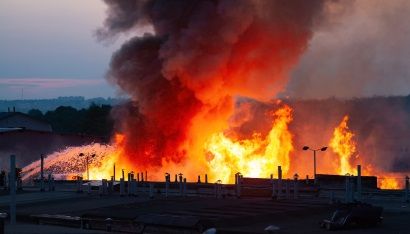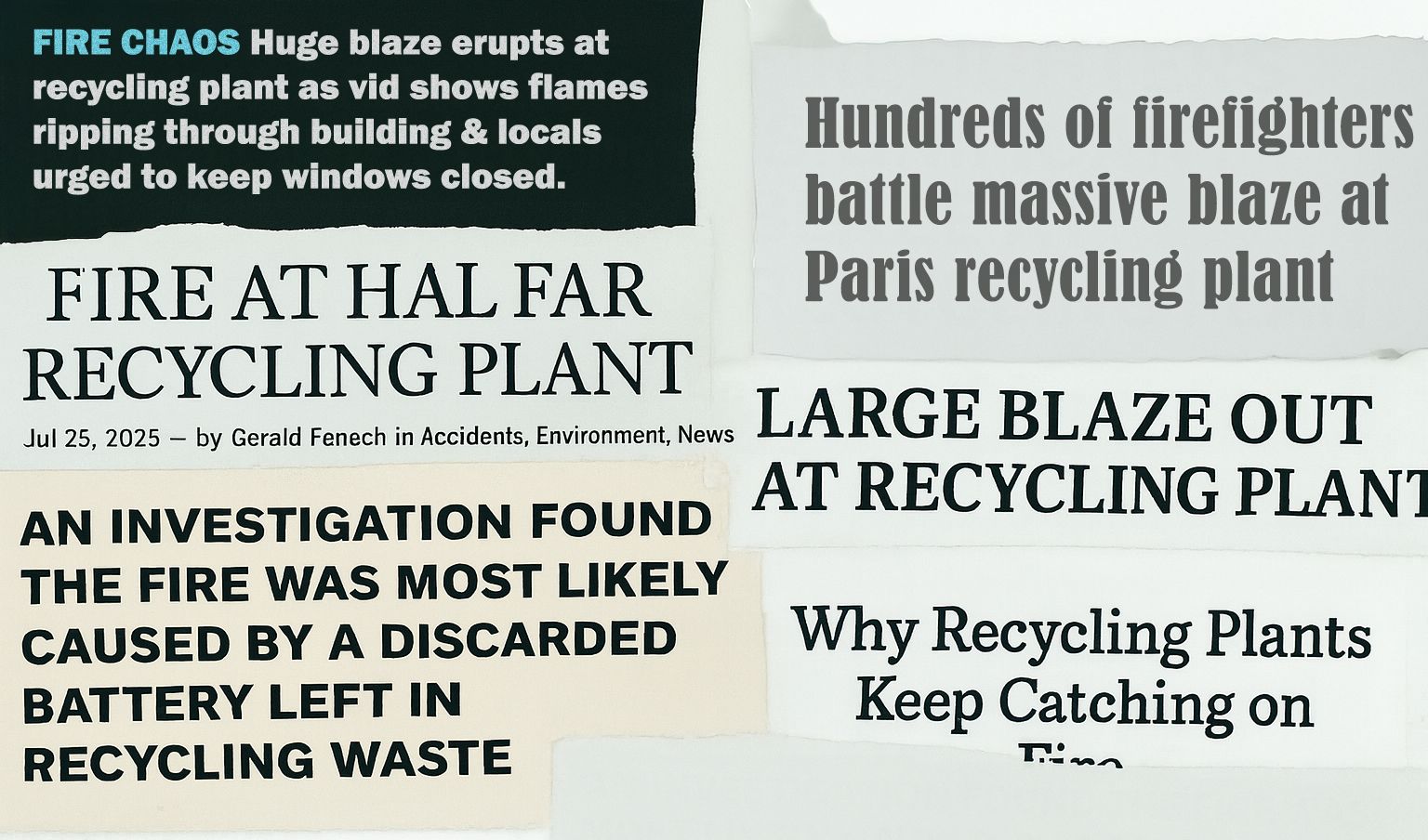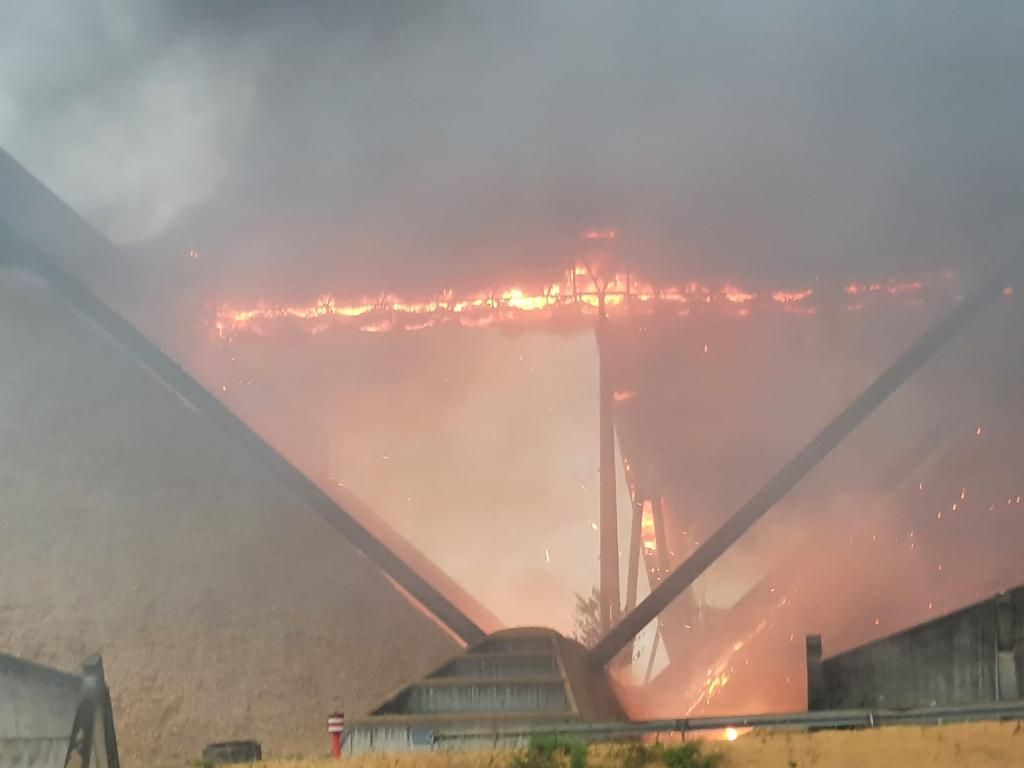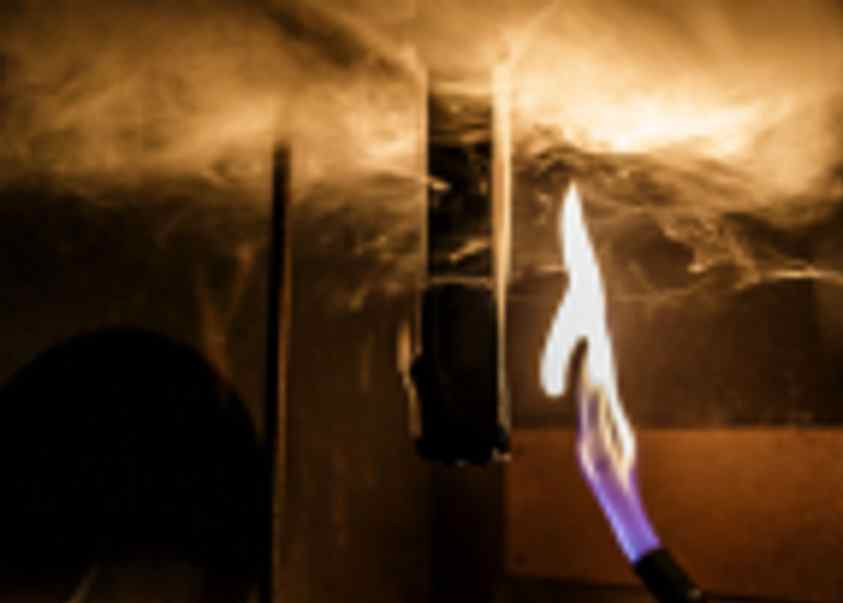When a lithium-ion battery cell is crushed, punctured or spontaneously shorts out, it can go into what is known as a ‘thermal runaway’ in seconds. It is causing devastating fires in recycling and waste plants around the world and is a rapidly growing problem that will only get worse because the lithium-ion battery boom is still in its infancy. The global battery recycling market is projected to grow roughly seven-fold over the next decade, reaching 24 billion U.S. dollars by 2033, together with a corresponding increase in battery-related fires.
- In France, the number of fires in waste treatment facilities linked to lithium batteries doubled between 2019 and 2023.
- In Austria, it is estimated that 180 to 240 fires per year in waste facilities are caused by batteries.
- In Germany, up to 30 fire incidents per day occur in waste collection vehicles and in waste treatment facilities, with 80% attributed to lithium batteries.
- In the UK, over 1,200 battery-related fires were reported in 2023 in refuse collection vehicles and at waste sites, marking a 71% increase from 2022.

Conventional conveyor belts can propagate fire at lightning speed. Fire-resistant belts tested according to ISO 340 or selected as per EN 12882 (for above-ground use) are designed to resist fire and limit flame spread by self-extinguishing within seconds once the immediate source of ignition is removed. But if a fire-resistant belt doesn’t self-extinguish quickly enough, and continue to do so, then it literally becomes a moving fuse.
FIREPROOF RUBBER CONVEYOR BELTS DO NOT EXIST
The vast majority of conveyor belts used in recycling and waste plants are a synthetic rubber multi-ply construction and the first thing to remember is that they can never be totally fireproof. The raw materials used to create the rubber and the inner ply fabrics (mostly polyester and nylon) are almost all directly or indirectly derived from crude oil. In fact, a typical conveyor belt is effectively 45% oil. Add to this a vast array of different chemical components such as anti-degradants, antiozonants and accelerators. Not surprisingly, once alight, they can be remarkably efficient at conveying flames at a frightening speed. Fortunately, the rubber can be engineered so that the belt’s ability to do so is dramatically reduced.
WHAT IS MEANT BY THE DESCRIPTION, FIRE-RESISTANT’?
Rather than ‘fire-resistant’, a more accurate description is “self-extinguishing”. This is because resistance is achieved by adding special chemicals and additives such as antimony trioxide, decabromodiphenyl, alumina trihydrate and magnesium hydroxide to the rubber compound during the mixing process. The actual amounts depend on the level (the international standard) of fire resistance required. When vulcanised fire-resistant rubber is ignited it emits gases that effectively suffocate (extinguish) the flames by starving them of oxygen.
PRICE IS THE DRIVER.
The special additives are costly so if low grade or insufficient quantities are used in order to keep the selling price sufficiently attractive to win orders then the ability of the belt to self-extinguish will be much slower and, as laboratory tests show, sometimes non-existent. In the past twenty years or so, the conveyor belt market, particularly in Europe, has been inundated by ‘cheap’ imports from Southeast Asia, primarily China. Performance, longevity and ultimately safety are all routinely sacrificed in the effort to win greater market share and force competitors out of business.
The reality is that it is impossible to make ‘economy’ versions of high-quality fire-resistant belts. The biggest single influence on the ability to resist fire is the quality of the rubber. Unfortunately, because it typically constitutes some 50% of the material cost of producing a conveyor belt, it is the prime cost saving target for so-called ‘economy’ manufacturers, even though they do not hesitate to claim that their products meet the same safety specification as the premium brand versions.
Despite the dangers, the top brand European manufacturers still face the same emphasis on price from buyers, especially in the recycling industry. However, the stark reality now facing recycling and waste plants, with insurance companies increasingly refusing to cover waste management facilities or dramatically increasing the cost of premiums, is that they are being forced to look at every possible way to mitigate the risks of large-scale fires. Such measures naturally include the obvious such as improved early warning alarms and water sprinkler systems. But high on that list of risk-reducing (insurance premium reducing?) measures should be conveyor belts that offer superior resistance to fire and therefore help slow fire propagation.
FIRE RESISTANT STANDARDS.
There are international and national standards relating to conveyor belt fire safety performance and separate standards that specify the test methods that measure that performance. The EN12882 standard is for safety requirements for conveyor belts for general-purpose, above ground applications and describes a range of classes from ‘1’, ‘2A’’, ‘2B’ up to ‘5C’. The most basic safety requirement is EN 12882 Class 1, which simply demands that the belt is anti-static. Class 2A (K grade) and Class 2B (S grade) make the distinction between fire resistance with covers and fire resistance with and without covers and are tested according to EN ISO 340 specified methods.
For most recycling applications, a premium brand EN 12882 Class 2A or Class 2B belt is most probably perfectly adequate but if you are at all unsure then seek expert advice. For conveying household waste or indeed any products that contain oils and greases, it is best to fit specialist belts that are resistant to both fire and oil.
A TEST OF SPEED
EN ISO 340 fire resistant testing involves exposing six individual samples of belt to a naked flame causing them to ignite. The source of the flame is then removed, and the combustion time (duration of continued flame) is recorded. A current of air is applied to the test piece for a specified time after the removal of the flame. The flame should not re-ignite.
The time it takes for the belt sample to self-extinguish after the flame has been removed is a maximum of 15 seconds for any individual sample with a maximum cumulative duration for each group of six samples of 45 seconds. This means that the maximum allowable average time per sample is 7.5 seconds. This factor is of paramount importance because it effectively determines the distance that the fire can be carried by belt when in motion.
Even if a manufacturer states that their fire-resistant belt has passed the ISO 340 test, caution must still be exercised. A typical conveyor belt will easily travel several meters within the 15 seconds allowed for a belt sample to pass the test, which is a potentially very dangerous distance. For this reason, one leading European manufacturer (Fenner Dunlop in The Netherlands) and who actually invented the very first fire resistant conveyor belts in the 1950’s, apply an average maximum time limit standard of less than one second, which is more than six times faster than the required standard and therefore decidedly safer.
ADDING FUEL TO THE FIRE.
The speed of suppression is super critical in the confines of recycling and waste plants. Fire safety experts describe the ignition of a lithium-ion battery as a chemical reaction that has the intensity of a blow torch and which can’t be stopped once it starts, with the duration very dependent on the size of the battery. Although these factors cannot be influenced, the speed at which the fire spreads along the conveyor belt very much depends on the ability of the rubber to inhibit the flames by starving them of oxygen. Without this ability, the belt can rapidly become a moving, burning mass, effectively adding fuel to the source of the fire. Apart from intense flames, burning rubber and the inner polyester and nylon synthetic fabrics release a lethal thick smoke that contains cyanide, carbon monoxide, sulfur dioxide and products of butadiene and styrene. With most recycling conveyors housed indoors, the risk to human life is significantly higher.
SEEK EXPERT ADVICE
Fire resistant conveyor belts really can be a matter of life and death so never hesitate to seek expert advice. The safest option is to use one of the leading European manufacturers who have well-founded reputations for having higher quality and safety standards. They are also much more willing to provide impartial technical support and advice. Although almost certainly higher priced, the cost of a fire-resistant conveyor belt that does not self-extinguish quickly enough when ignited by an exploding lithium-ion battery pales into insignificance.
Author: Leslie David






